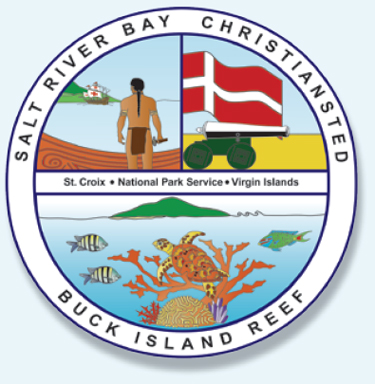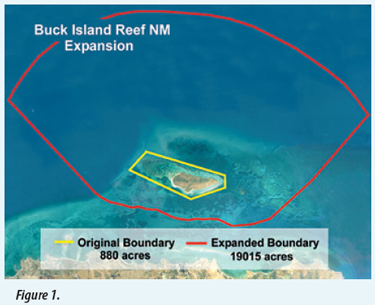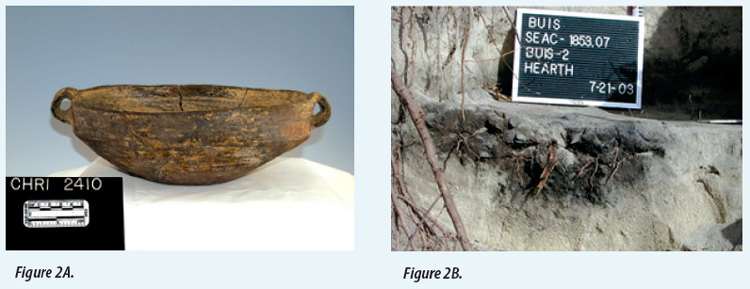 Artifacts – Inhabitants – Shipwrecks
Artifacts – Inhabitants – Shipwrecks
Joshua M. Torres, PhD – National Park Service, Cultural Resource Program Manager
Part 6 in a series
Buck Island Reef National Monument, located off the northeast coast of St. Croix (Figures 1), was established Presidential Proclamation (No. 3443), in December 1961. The Monument’s purpose is to protect the island and the adjoining shoals, rocks, and undersea coral reef formations that compose one of the finest marine gardens in the Caribbean Sea, as well as the rare marine life that inhabit these waters. In addition to its natural wealth, Buck Island has been the scene of much cultural activity over the centuries, playing an integral role in the history of St. Croix.
 Buck Island was first occupied by pre-Columbian peoples associated with the Ostionoid and Taino era (ca. AD 600 – AD 1400). Archaeological evidence from the island, in the form of pre-Columbian pottery and radiocarbon dates from a buried campfire hearth, indicate that the island was inhabited by at least AD 600 (Figure 2). Due to the lack of freshwater on the Island it is unlikely that the island was permanently in habited. Rather, during this time Buck Island was likely used as a seasonal fishing campsite.
Buck Island was first occupied by pre-Columbian peoples associated with the Ostionoid and Taino era (ca. AD 600 – AD 1400). Archaeological evidence from the island, in the form of pre-Columbian pottery and radiocarbon dates from a buried campfire hearth, indicate that the island was inhabited by at least AD 600 (Figure 2). Due to the lack of freshwater on the Island it is unlikely that the island was permanently in habited. Rather, during this time Buck Island was likely used as a seasonal fishing campsite.
Since at least 1754, enslaved Africans were sent to Buck Island to harvest lignurnvitae trees, a very strong wood used in ship and building construction. A few colonists lived on the higher ridges of the island, to maintain the Royal Signal Station. Ships destined for or leaving Christiansted harbor had to navigate around Buck Island’s coral reefs, and occasionally wrecked on them.
Johann Deidrich, the town clerk for Christiansted, became one of the island’s first stewards from 1754 to 1773. Deidrich built a house atop the island which provided an unparalled view of the shipping lanes. Deidrich, a man of social and political stature, probably never lived on the island, but several of his slaves did. It is known that between 6 and 12 enslaved Africans were on the island during Deidrich’s tenure. They probably harvested lignum vitae trees, land-crabs, and lobsters, and survived on the island by fishing, gathering shellfish, planting sweet potatoes, and catching rainwater in above-ground cisterns.
In 1773, control of the island was transferred to Nicolay Salamon. In 1774, Joseph Coakley was listed as managing the island for Salamon, with his wife and two slaves. Coakley remained the tenant until 1780, when John Heyliger Abrahamson was listed. Abrahamson was the caretaker and taxpayer of the island from 1780 to 1797. In 1789, the Danish government constructed a signal station on the islands highest ridge. The signal keeper and his family would have lived nearby, along with their slaves. In 1797, John Benners took the position, and in 1802 John de Graff Godette was listed at the island. By 1804, however, Abrahamson was back and stayed until 1818, and again from 1823 to 1826.
In 1822, Buck Island became the official possession of the Danish Crown through the practice of landskassen (land treasury). The island was leased to various individuals for various uses–as determined appropriate by the Danish government. Census data through the nineteenth century note that small groups living on Buck Island. For example, in 1841, six people were living on the island: two fishermen, a housekeeper, and “three professional drunks”. Christopher Love was a fisherman from Copenhagen, and the other residents were from St. Croix. The other fisherman was Christian Petersen; the housekeeper was Peggy Conrad, and the three drunkards were Robert Sylvester, and John and Jacobine. Christopher Love owned two slaves: John, a fisherman, and Lucy, a cook. Love died by 1844, and Niehls Boun petitioned to assume Love’s responsibilities. Leases were granted for grazing goats on Buck Island until the 1920s, and it was not until the 1940s before all remaining feral goats were removed.

Because Buck Island is surrounded by coral reefs, and the reef’s proximity to Christiansted harbor, a number of ships have wrecked here. Two of these were British slaving vessels, the Mary (1797) and the General Abercrombie (1803). In both cases, the people and cargo were saved and many other items were salvaged and later sold at auction.
In 1948, the Government of the Virgin Islands established Buck Island and its surrounding reefs as a territorial park. On December 5, 1961, concontrol of Buck Island and adjacent submerged lands and waters were transferred to the National Park Service, for the purpose of becoming a National Monument. On January 17, 2001, President William J. Clinton, expanded the Monument’s size by 18,135 acres. This proclamation established the entirety of Buck Island’s submerged lands as a “no-take” zone, as well as prohibiting boat anchoring except by permit only. Under the protection of the National Park Service, Buck Island’s beauty can be enjoyed by all who come to visit her.
National Park Service
340-773-1460
www.nps.gov/buis
Mobile App ‘NPS-St.Croix’
Keep in touch with all 3 National Parks on St. Croix!
